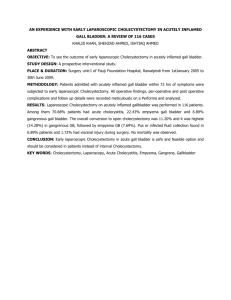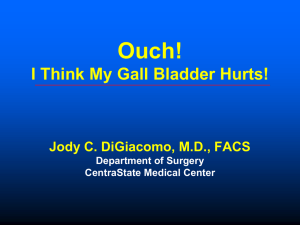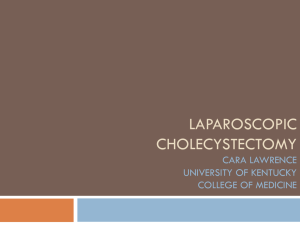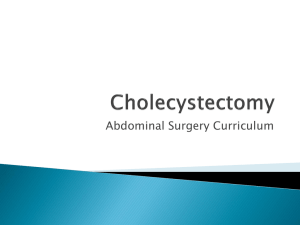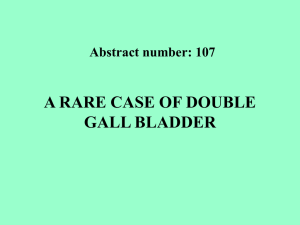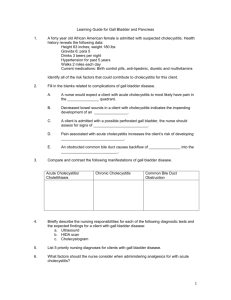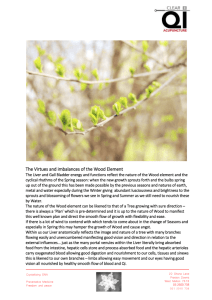A Co-relative Study of Intra Operative findings and Post
advertisement
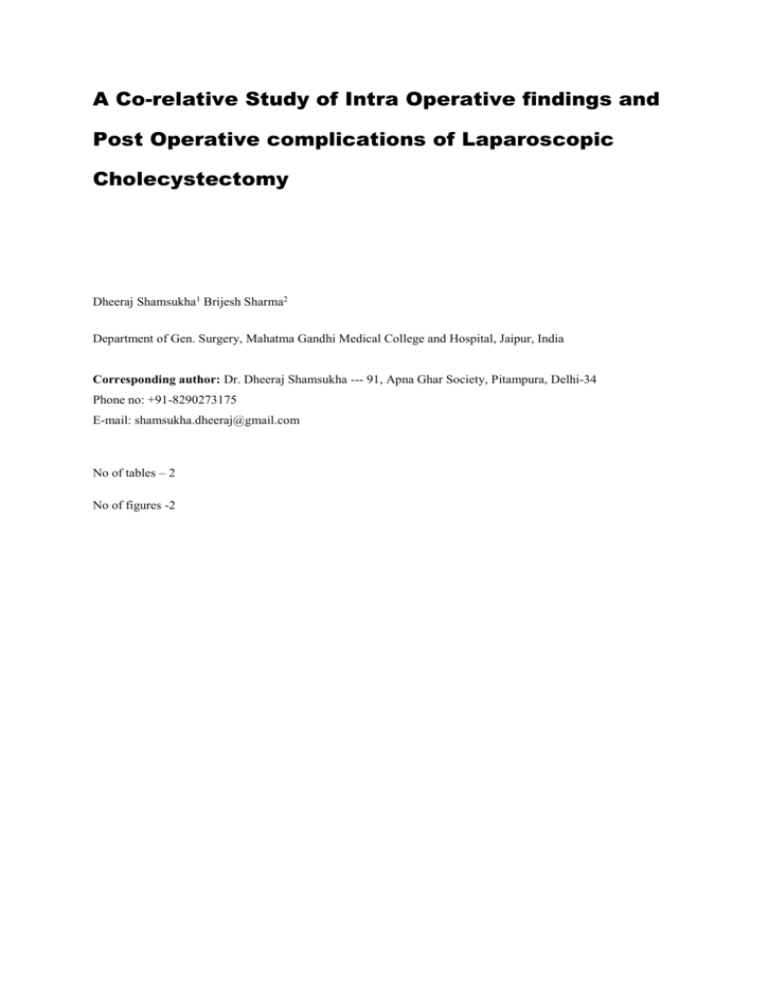
A Co-relative Study of Intra Operative findings and Post Operative complications of Laparoscopic Cholecystectomy Dheeraj Shamsukha1 Brijesh Sharma2 Department of Gen. Surgery, Mahatma Gandhi Medical College and Hospital, Jaipur, India Corresponding author: Dr. Dheeraj Shamsukha --- 91, Apna Ghar Society, Pitampura, Delhi-34 Phone no: +91-8290273175 E-mail: shamsukha.dheeraj@gmail.com No of tables – 2 No of figures -2 ABSTRACT Introduction: This study has been carried out with an objective to study the outcome of the intra operative findings in terms of post operative complications and patient recovery of laparoscopic cholecystectomy. Materials and Methods: Sixty patients operated for laparoscopic cholecystectomy were studied prospectively. The parameters studied were age and sex of the patients, operative time, hospital stay, return to normal activity, intraoperative findings and complications. Result: The intraoperative findings related to gall bladder pathology were – edematous thick walled gall bladder 2 (3.3%), empyema 2 (3.3%), sessile gall bladder 1 (1.6%), contracted fibrotic gall bladder 6 (10%), mucocele 1 (1.6%), chronic cholecystitis with dense fibrotic adhesions in calot’s triangle 5 (8.3%), anomalous cystic artery (moynihan’s hump) 1 (1.6%), stone impacted at neck 6 (10%), chronic cholecystitis with minor adhesions in calot’s triangle 27 (45%), adhesions of gall bladder with omentum or surrounding structures 9 (15%). Average operative time was 49.2 minutes in the present study. Two cases were converted to open cholecystectomy. The conversion rate to open cholecystectomy was low (3.3%). Intraoperative complications occurred in 4 (6.66%) patients. Spillage of stone and bile was present in 3 (5%) postoperative complications occurred in 7 (11.6%) patients. Wound infection was present in 1 patient, shoulder pain in 5 patients, prolonged ileus in 1 patient. The mean postoperative hospital stay of the patients of the present study was 2.26 days (range 1 – 5.5 days) and 2.22 in uncomplicated cases. Average time for return to normal activity was 10.56 days (range 7-16 days). Conclusion: Our study summarizes a varied range of intraoperative findings during laparoscopic cholecystectomy which in turn helped us to assess the expected and practical outcome of surgery. Keywords Cholelithiasis, Gall bladder, Calot’s triangle, Cholecystitis. Introduction The introduction of laparoscopic cholecystectomy has emerged as the gold standard for the treatment of patients with symptomatic gall stones. It is being performed as a day care surgery thus saving on human and hospital working hours. The advantage of laparoscopic cholecystectomy is greater, especially in developing countries where demands for hospital bed are great and early return to work a financial necessity (Teerawattananon, Mugford M 2005). Laparoscopic cholecystectomy is a newly developed technique that avoids the traditional upper abdominal incision, diminished postoperative pain, more rapid recovery with full return to activity and superior cosmetic results (Perissat J. 1993). Because of these advantages, laparoscopic cholecystectomy has become the “GOLD STANDARD” for the management of gall stone disease (Imdahl 2005). Patel and Veverka 2002 showed that laparoscopic cholecystectomy can be performed safely in pregnant patient in the first two trimesters; while open cholecystectomy should be considered the procedure of choice in patient with severe cholecystitis, empyema of gall bladder, acute cholangitis, gall bladder perforation, cholecyst-enteric fistula or a suspected gall bladder neoplasm. The major concern relating to complication of Laparoscopic surgery is of an increased rate of accidental injury to adjacent structures as a result of loss of three dimensional vision, reduced visual field and loss of tactile sensation together with the price of learning curve.The intra operative findings of laparoscopic cholecystectomy have played a major role in the post operative complications and in turn the recovery of the patient. It has been observed that intraoperative findings such as adhesions in Calot’s triangle, adhensions between gall bladder and duodenum, relation of gall bladder with liver i.e. due to repeated inflammation plane, between gall bladder and liver is obliterated, and developemental anomalies which are easily missed on ultrasonography have a great influence on the outcome of the surgery in terms increased operative time and hence risk of anaesthesia and CO2 toxicity. Complications associated with laparoscopic cholecystectomy as observed are haemorrhage, bile duct injury, bile leak, rupture gall bladder and spilled gall stones during laparoscopic cholecystectomy, acute post operative pancreatitis(due to migration of stone), wound infection, incisional hernia, pneumo peritoneum related complications like CO2 embolism, vaso vagal reflex, cardiac arrhythmias, hypercarbic acidosis, trochar related abdominal wall bleeding, haematoma, visceral injury, vascular injury, etc. are also known. Keeping the above facts in mind, the literature has been reviewed and this study has been carried out to analyze the outcome of the intra operative findings in terms of post operative complications and patient recovery. Material and Methods The study constitute of 60 patients which were admitted in Mahatma Gandhi Medical College and Hospital, Jaipur with surgical dyspepsia, pain in right upper quadrant of abdomen with or without nausea and vomiting as their complaints All patients were investigated for routine blood investigations like CBC, urine routine and microscopic, blood urea, serum creatinine and random blood sugar,blood grouping, HIV,HBsAG Liver function tests done in all patients to see for liver insufficiency or obstruction to CBD, Chest X-ray and ECG were done in all patients,USG of abdomen was the baseline investigation for all patients for confirmation of diagnosis. All patients posted for laparoscopic surgery were explained in detail about the procedure and about possible conversion to open cholecystectomy when needed. A well Informed, explained and written consent was taken of all patients who were posted for laparoscopic cholecystectomy ,all patients were operated under general anesthesia. METHODS Laparoscopic Cholecystectomy Position : Supine with 20-300 Reverse Trendelenburg for creation of Pneumo-peritoneum. Position of surgeon :To left side of the patient. Standard operative teqnique used . Postoperative Care Antibiotics: Three doses of i/v antibiotics are enough.first preoperatively, second postoperatively and last at night operated day. Then patient is put on oral antibiotics (Most commonly 2 nd generation cephalosporin cephalexin). IV fluids : 5% dextrose on first postoperative day, then oral is started. Physiotherapy: Essential to encourage respiration and to keep limb mobile, patient is encouraged to walk early. Drain : Removed after drainage is stopped. Discharge : Patient is encouraged to walk as soon as it is possible. Patients are discharged after 48-72 hours of surgery once they start taking fluid/semisolid full orally and passed stool. Follow up:Patients are followed up regularly for 3 months . Observations In our study 27 (45%) cases showed chronic cholecystitis with cholelithiasis with minor adhesions in the calot’s triangle.There are two cases (3.3%) of oedematous thick walled gall bladder.Two cases (3.3%) of empyema gall bladder and 5 cases (8.3%) cholecystolithiasis with dense fibrotic adhesions in the calot’s triangle.There was one case of chronic cholecystolithiasis with sessile gall bladder in that case internal knotting was done in the interest of the patient care. 6 cases (10 %) were of contracted gallbladder rest of the 54 cases were normal capacity (50 ml or more) and 6 (10%) having stone in the neck, rest of the 54 cases had free mobile gall stones, 2 cases (3.3%) were of empyema gall bladder, in which gall bladder wall was difficult to be held with instruments so they were aspirated per abdomen by aspiration needle before Calot’s triangle dissection. One case of mucocele which was aspirated first then Calot’s triangle dissection was carried out and one case of anomalous cystic artery (Myonihans hump) which was managed uneventfully TABLE 1 INTRAOPERATIVE FINDINGS Intraoperative findings Acute cholecystitis with Chronic cholecystitis cholelithiasis with cholelithiasis 0 27 Edematous thick walled gall bladder 2 0 Empyema gall bladder 2 0 Chronic cholecystitis with analmous cystic 0 1 0 5 Mucocele 1 0 Adhesions of gall bladder with omentum or 0 9 0 1 Contracted fibrotic gall bladder 0 6 Stone impacted at the neck 0 6 Gangrenous gall bladder 0 0 Chronic cholecystitis with minor adhesions in Calot’s triangle artry (Moynihan’s hump) Chronic cholecystitis with dense fibrotic adhensions in Calot’s triangle surrounding structures Chronic cholecystolithiasis with sessile gall bladder 30 25 20 15 10 5 0 TABLE 2 COMPLICATIONS Complications Acute cholecystitis with Chronic cholecystitis with cholelithiasis cholelithiasis CBD Injury 0 0 Wound infection 1 0 Spillage of stone 0 2 Jaundice 0 0 Biliary stricture 0 0 Shoulder pain 1 4 Incisional hernia 0 0 Pulmonary complication 0 0 DVT 0 0 Bowel injury 0 0 Prolonged ileus 1 0 Pancreatitis 0 0 Haemorrhage 0 0 Mortality 0 0 4 3.5 3 2.5 2 1.5 1 0.5 0 Mortality Haemorrhage Pancreatitis Prolonged ileus Bowel injury DVT Pulmonary complication Incisional hernia Shoulder pain Biliary stricture Jaundice Spillage of stone Wound infection CBD Injury Discussion The results of the present study, “Intraoperative findings and postoperative complications in laproscopic Cholecystectomy” were compared with the following studies from other hospitals. Study I First department of Propaedentic Surgery, Antheus University Hippocration Hospital Greece (1788 patients) Study II From the Department of surgery, University of Maryland, School of Medicine, Baltimore, Maryland (375 patients). Study III Ohio digestive institute Colombus, Ohio (study of 100 patients) Study IV From Gastrointestinal Surgical and Liver transplant Unit, Flinderes Medical Centre, Bedford Park Australia (418 patients). Study V Service de Chirurgie digested, paris, France (121 patients) In compared studies intraoperative cholangiography was performed in many patients which increased their operative time. In our study intraoperative cholangiography was not performed in any case which decreases the operative time. Operative time was more with initial phase which later decreased with experience. This “learning curve” represents adapting to operating on two dimensional screen, becoming familiar with instruments, tuning and training of the staff with time (Buchmann and Dincler, 2005). In the present study, the hospital stay was 2.2 day, when compared to study I (1.8 days), study II (1.3+0.1 day.) in study III (1.3 days), study-IV (2 days). However, our mean hospital stay was longer, because when calculating the average length of hospital stay we included all cases with complications and all those considered to open cholecystectomy which required prolonged hospitalization, average hospital stay in uncomplicated cases was 2.15 days. Bueno-Leedo J, noted that intra operative variables predictive of postoperative hospital stay were operative time of more than 60 minutes, gall bladder dissection with anatomic difficulty and cystic artery haemorrhage. Surgical access to the abdominal cavity, gall bladder perforation, trochar wound or hepatic bed bleeding intensity or grade of haemorrhage and gall bladder extraction were not predictive variables of length of post operative hospital stay (Bueno-Lledo J, Planells Roig M et al, 2005). The reasons for conversion to open cholecystectomy in the present study were adhesion in calot’s triangle with distorted anatomy. In one case acute cholecystitis with cholelithiasis, dissection was difficult and non progressive so we converted the case to open cholecystectomy in the interest of the patient. In the second case gall bladder was contracted with thick cystic duct and adhesions between Hartman’s pouch and duodenum leading to difficult dissection so we converted the case to open cholecystectomy. The conversion rate in the presence of acute or chronic inflammation was significantly higher than that for cases with no obvious inflammation. The conversion rate for acute cholecystitis was also significantly higher (20%) than that for chronic cholecystitis (1.9%) (Cox and Wilson, 1993). In the present study, there was no common bile duct injury. In study IV common bile duct injury occurred in 1 patient among the 418 patients. The overall accepted incidence rate of bile duct injury during laparoscopic cholecystectomy is 0.25 – 1.3% according to the experience of surgeon (Gigat J, Etienner J et al 1997). Routine intra-opertive cholangiography helps in the immediate identification of injuries and the institution of appropriate therapy; injury is not completely prevented (Debru E, Dawson A, et al, 2005). Careful dissection and correct interpretation of anatomy avoids the complications of bile duct injury during cholecystectomy. Routine intraoperative cholangiography is associated with a lower incidence and early recognition of bile duct injury (Connor S Garden OJ et al, 2006). In the present study, there was spillage of stones and bile in three patients, due to perforation of gall bladder during gall bladder dissection from the liver bed or during extraction of gall bladder form the epigastric port. All the spilled stones were recovered and bile leakage area was irrigated with normal saline solution. Their postoperative course was uneventful. In the study V, there was spillage of stone and bile in 24 patient out of 121 patients. “Every effort must be made to prevent gall bladder perforation. When it does occur all stones should be retrieved. Attempts at repairing gall bladder perforation are often unsatisfactory. A simple solution to this potential problem is to retrieve all stones immediately, place them in an intra peritoneal specimen bag and park the bag on the liver. As soon as the gall bladder is dissected of the liver, it should be placed in the specimen bag with stones and removed through the 10 mm port opening (Patterson EJ Nagy AG et al, 1997).” Long term follow up of the patients with retained stones during laparoscopic cholecystectomy revealed no harm caused by retained stones (Manukyan MN, Demirkalem P et al, 2005). In the present study no CBD injury occurred. In study IV it occurred in 1 patient among the 418 patients. Early detection of the duct injuries caused by laparoscopy, complete evaluation of the bile duct and appropriate surgical modality and technique are helpful to improve the results of repair for laparascopic bile duct injuries (Li LB, Cai XJ et al 2005). Careful dissection and correct interpretation of the anatomy avoids the complications of bile duct injury during laparoscopic cholecystectomy (Connors S, Garden OJ et al, 2006). The overall accepted incidence rate of bile duct injury during laparoscopic cholecystectomy is 0.35 to 1.3% according to the experience of surgeon (Gigat J, Etienne J et al, 1997). In the present study wound infection occurred in 1 out of 60 cases (1.66%). The wound infection occurred at epgastric port probably because we extract the gall bladder through epigastric port which leads to the increased risk of contamination of the port with infected bile. In the present study there was no bile leakage in any patients post-operatively because during separation of gall bladder from the liver bed we were using coagulation cautry with meticulous dissection which coagulates the minor accessory duct which later on possibly may lead to bile leakage from the liver bed. In study I there was leakage of bile in 6 out of 1788 patients. In study IV there was leakage of bile in 7 out of 418 patients. In the present study shoulder pain occurred in 5 patients out of 60(8.3%) cases which is significant when compared to study I and study IV where none of the patients had shoulder pain. The reason for shoulder pain was probably high insufflations pressure and CO2 retention in the present study, but we are not discouraging use of high insufflations pressure because it reduces the operative time and excess CO2 leads to better and wider visualization of field. It has been observed that intraoperative findings such as adhesions in Calot’s triangle, adhensions between gall bladder and duodenum, relation of gall bladder with liver i.e. due to repeated inflammation, plane between gall bladder and liver is obliterated; which are easily missed on ultrasonography have a great influence on the outcome of the patients in terms of putting the drain, operative time and hence risk of anaesthesia, CO2 toxicity and conversion to open cholecystectomy. It has also been observed that ultrasonography is not very accurate in assessing the length of cystic duct and gall bladder wall thickness. Intraoperative findings also have a great impact on postoperative complications. Common bile duct injury can occur in cases of thick dense fibrotic adhensions in calot’s triangle, While separating adhesions between gall bladder and duodenum, thermal injury can occur to duodenum which is sometimes not noted preoperatively. Bile leakage occurs on 3rd or 4th post operative day when sloughing of necrotized part occurs. Various anomalies of cystic duct, cystic artery, gall bladder are seen intra-operatively. Though ultrasonography can suggest the difficulty of a case, and subsequent conversion to open cholecystectomy, but it is laparoscopy which gives the accurate idea about the difficulty of a case. There is no contra indication to laparoscopic cholecystectomy now a days-everything depends upon the expertise of the surgeons and availability of equipment so much so that even complications can be managed laparoscopically Conclusion From this study we conclude that intraoperative findings which are usually not picked up by ultrasonography preoperatively such as adhesions in Calot’s triangle, adhesions between gall bladder and surrounding structure, relation of gall bladder with liver i.e. due to repeated inflammation plane between gall bladder and liver is obliterated has a great impact on the outcome of patients in terms of longer operative time, hence risk of anesthesia, carbon dioxide toxicity, CBD injury, conversion to open cholecystectomy, bowel injury etc. Intraoperative findings also has great influence on the postoperative complications like CBD injury can occur in cases of thick fibrotic adhesion in Calot’s triangle, thermal injury to gut while breaking adhesion between gall bladder and surrounding gut. Although ultrasonography can suggest only the difficulty of a case but it is the laparoscopic intraoperative findings which gives the accurate idea of potential difficulties that a surgeon can face in that particular patient. References 1. Bailey RW, Zucker KA, Flowers JL, Scovill WA, Graham SM, Imbembo AL. Laparoscopic cholecystectomy. Experience with 375 consecutive patients. Ann Surg. 1991 Oct; 214(4):531-40. 2. Barrat C, Champault A, Matthyssens L, Champault G. Iatrogenic perforation of the gallbladder during laparoscopic cholecystectomy does not influence the prognosis. Prospective study. Annales de Chirurgie; 2004; 129(1):25-29. 3. Bonatsos G, Leandros E, Dourakis N, Birbas C, Delibaltadakis G, Golematis B. Laparoscopic cholecystectomy. Intraoperative findings and postoperative complications. Surg Endosc. 1995 Aug;9(8):889-93. 4. Buchmann P, Dincler S. Learning curve-calculation and value in laparoscopic surgery. Ther Umsch, 2005; 62 (2): 69-75. 5. BUeno-Lledo J, Planells Roig M, Sanahuja Santafe A, Garcia Espinosa R, Arnau Bertomeu C, Guillemot M. intraoperative factors predictive of failure of the ambulatory regimen after laparoscopic cholecystectomy., Cir Esp 2005. 78 (3): 168-74. 6. Connor S, Garden OJ. Bile duct injury in the era of laparoscopic cholecystectomy. Br J Surg 2006; 93 (5): 158-68. 7. Cox MR, Wilson TG, Luck AJ, Jeans PL, Padbury RT,Toouli J. lapraroscopic cholecystedctomy for acute inflammation of the gallbladder.Ann Surg.1993 Nov:218(5):630-4. 8. Debru E, Dawson A, Leibman S, Richardson M, Glen L, Hollinshead J, Falk GL. Does routine intraoperative cholangiography prevent bile duct transaction ? Surg Endos 2005; 19 (4): 589-93. 9. Giget J, Etienne J, Aerts R, Wibin E, Dallemagne B, Dewwer F, Fortunati D, Legrand M, Vereecken L, Doumont J, Van Reepinghem P, Beguin C.The dramatic reality of biliary tract injury during laparoscopic cholecystectomy. An anonymous multicentre Belgian survey of 65 patients. Surg Endosc.1997 Dec:11(12):1171-8. 10. Imdahl A. Laparoscopic Cholecystectomy is the current standard intervention. MMW Fortschr Med 2005; 147(2): 22-25. 11. Li LB, Cai XJ, Mou YP, Wei Q, Wang XF. Factors influencing the result of treatment of bile duct injuries during laparoscopic cholecystectomy. Hepatobiliary Pancreat Dis Int 2005; 4 (1): 113-6. 12. Manukyan MN, Demirkalem P, Gulluoglu BM, Tuney D, Yegen C, Yalin R, Aktan AO. Retained abdominal gallstones during laparoscopic cholecystectomy. Am J Surg 2005; 189 (4): 450-52. 13. Patel SG, Veverka TJ. Laparoscopic cholecystectomy in pregnancy. Curr Surg 2002, 59(1): 74-78. 14. Patterson EJ, Nagy AG. Don’t cry over spilled stones? Complications of gallstones spilled during laparoscopic cholecystectomy: case report and literature review. Can J Surg 1997;40 (4): 300-4. 15. Perissat J. Laparoscopic cholecystectomy: the European experience. Am J Surg 1993; 165:444. 16. Peters JH, Gibbons GD, Innes JT et al. complications of lc surg. 1991 : 110: 769-778. 17. Teerawattananon Y, Mugford M. is it worth offering a routine laprascopic cholecystectomy in developing countries? A Thailand case study. Cost Eff Resour Alloc 2005:3(1):10. Intra operative pictures
